Oil Price Shocks to Foreign Assets and Liabilities in Saudi Arabia under Pegged Exchange Rate
Abstract
1. Introduction
2. Methodology
2.1. Data, Definition, and Source
2.2. Quantile-on-Quantile Approach
2.3. Cross-Quantilogram Dependence
2.4. TVP-VAR
3. Results and Discussion
3.1. Descriptive Analysis
3.2. Cross-Quantilogram
3.3. Quantile-on-Quantile
3.4. Time-Frequency Analysis
4. Conclusions
Author Contributions
Funding
Institutional Review Board Statement
Informed Consent Statement
Data Availability Statement
Acknowledgments
Conflicts of Interest
References
- Bodenstein, M.; Erceg, C.J.; Guerrieri, L. Oil shocks and external adjustment. J. Int. Econ. 2011, 832, 168–184. [Google Scholar] [CrossRef]
- Bova, M.E.; Medas, M.P.A.; Poghosyan, M.T. Macroeconomic Stability in Resource-Rich Countries: The Role of Fiscal Policy; International Monetary Fund: Washington, DC, USA, 2016. [Google Scholar]
- Jibril, H.; Chaudhuri, K.; Mohaddes, K. Asymmetric oil prices and trade imbalances: Does the source of the oil shock matter? Energy Policy 2020, 137, 111100. [Google Scholar] [CrossRef]
- Kilian, L.; Rebucci, A.; Spatafora, N. Oil shocks and external balances. J. Int. Econ. 2009, 772, 181–194. [Google Scholar] [CrossRef]
- Le, T.-H.; Chang, Y. Oil price shocks and trade imbalances. Energy Econ. 2013, 36, 78–96. [Google Scholar] [CrossRef]
- Lopez-Murphy, P.; Villafuerte, M. Fiscal policy in oil producing countries during the recent oil price cycle. IMF Work. Pap. 2010, 1–23. [Google Scholar]
- Rafiq, S.; Sgro, P.; Apergis, N. Asymmetric oil shocks and external balances of major oil exporting and importing countries. Energy Econ. 2016, 56, 42–50. [Google Scholar] [CrossRef]
- Backus, D.K.; Crucini, M.J. Oil prices and the terms of trade. J. Int. Econ. 2000, 501, 185–213. [Google Scholar] [CrossRef]
- Baek, J. An asymmetric approach to the oil prices-trade balance nexus: New evidence from bilateral trade between Korea and her 14 trading partners. Econ. Anal. Policy 2020, 68, 199–209. [Google Scholar] [CrossRef]
- Fratzscher, M.; Schneider, D.; Van Robays, I. Oil prices, exchange rates and asset prices. ECB Work. Pap. 2013. [Google Scholar] [CrossRef]
- Sim, N.; Zhou, H. Oil prices, US stock return, and the dependence between their quantiles. J. Bank. Financ. 2015, 55, 1–8. [Google Scholar] [CrossRef]
- Nasir, M.A.; Naidoo, L.; Shahbaz, M.; Amoo, N. Implications of oil prices shocks for the major emerging economies: A comparative analysis of BRICS. Energy Econ. 2018, 76, 76–88. [Google Scholar] [CrossRef]
- Yildirim, Z.; Arifli, A. Oil price shocks, exchange rate and macroeconomic fluctuations in a small oil-exporting economy. Energy 2021, 219, 119527. [Google Scholar] [CrossRef]
- Hathroubi, S.; Aloui, C. Oil price dynamics and fiscal policy cyclicality in Saudi Arabia: New evidence from partial and multiple wavelet coherences. Q. Rev. Econ. Financ. 2020, 85, 149–160. [Google Scholar] [CrossRef]
- Allegret, J.P.; Mignon, V.; Sallenave, A. Oil price shocks and global imbalances: Lessons from a model with trade and financial interdependencies. Econ. Model. 2015, 49, 232–247. [Google Scholar] [CrossRef]
- Balli, E.; Çatık, A.N.; Nugent, J.B. Time-varying impact of oil shocks on trade balances: Evidence using the TVP-VAR model. Energy 2021, 217, 119377. [Google Scholar] [CrossRef]
- Eryiğit, M. The dynamical relationship between oil price shocks and selected macroeconomic variables in Turkey. Econ. Res.-Ekon. Istraž. 2012, 25, 263–276. [Google Scholar] [CrossRef][Green Version]
- Gnimassoun, B.; Joëts, M.; Razafindrabe, T. On the link between current account and oil price fluctuations in diversified economies: The case of Canada. Int. Econ. 2017, 152, 63–78. [Google Scholar] [CrossRef]
- Gomes, G.; Hache, E.; Mignon, V.; Paris, A. On the current account-biofuels link in emerging and developing countries: Do oil price fluctuations matter? Energy Policy 2018, 116, 60–67. [Google Scholar] [CrossRef]
- Huntington, H.G. Crude oil trade and current account deficits. Energy Econ. 2015, 50, 70–79. [Google Scholar] [CrossRef]
- Long, S.; Liang, J. Asymmetric and nonlinear pass-through of global crude oil price to China’s PPI and CPI inflation. Econ. Res.-Ekon. Istraž. 2018, 31, 240–251. [Google Scholar]
- Özlale, Ü.; Pekkurnaz, D. Oil prices and current account: A structural analysis for the Turkish economy. Energy Policy 2010, 388, 4489–4496. [Google Scholar] [CrossRef]
- Okolo, C.V.; Udabah, S.I. Oil price and exchange rate volatilities: Implications on the cost of living in an OPEC member country—Nigeria. OPEC Energy Rev. 2019, 43, 413–428. [Google Scholar] [CrossRef]
- Varlik, S.; Berument, M.H. Oil price shocks and the composition of current account balance. Cent. Bank Rev. 2020, 201, 1–8. [Google Scholar] [CrossRef]
- Han, H.; Linton, O.; Oka, T.; Whang, Y.-J. The cross-quantilogram: Measuring quantile dependence and testing directional predictability between time series. J. Int. Econ. 2016, 1931, 251–270. [Google Scholar] [CrossRef]
- Antonakakis, N.; Gabauer, D. Refined Measures of Dynamic Connectedness Based On TVP-VAR. 2017. Available online: https://mpra.ub.uni-muenchen.de/78282/1/MPRA_paper_78282.pdf (accessed on 29 September 2022).
- Koop, G.; Korobilis, D. A new index of financial conditions. Eur. Econ. Rev. 2014, 71, 101–116. [Google Scholar] [CrossRef]
- Koop, G.; Pesaran, M.H.; Potter, S.M. Impulse response analysis in nonlinear multivariate models. J. Econ. 1996, 741, 119–147. [Google Scholar] [CrossRef]
- Sohag, K.; Gainetdinova, A.; Hammoudeh, S.; Shams, R. Dynamic Connectedness among Vaccine Companies’ Stock Prices: Before and after Vaccines Released. Mathematics 2022, 10, 2812. [Google Scholar] [CrossRef]
- Diebold, F.X.; Yılmaz, K. On the network topology of variance decompositions: Measuring the connectedness of financial firms. J. Int. Econ. 2014, 1821, 119–134. [Google Scholar] [CrossRef]
- Pesaran, H.H.; Shin, Y. Generalized impulse response analysis in linear multivariate models. Econ. Lett. 1998, 581, 17–29. [Google Scholar] [CrossRef]
- Chandrarin, G.; Sohag, K.; Cahyaningsih, D.S.; Yuniawan, D.; Herdhayinta, H. The response of exchange rate to coal price, palm oil price, and inflation in Indonesia: Tail dependence analysis. Resour. Policy 2022, 77, 102750. [Google Scholar] [CrossRef]
- Mezghani, T.; Boujelbène, M. The contagion effect between the oil market, and the Islamic and conventional stock markets of the GCC country: Behavioral explanation. Int. J. Islam. Middle East. Financ. Manag. 2018, 11. [Google Scholar] [CrossRef]
- Wang, R.; Luo, H.R. Oil prices and bank credit risk in MENA countries after the 2008 financial crisis. Int. J. Islam. Middle East. Financ. Manag. 2020, 13, 219–247. [Google Scholar] [CrossRef]
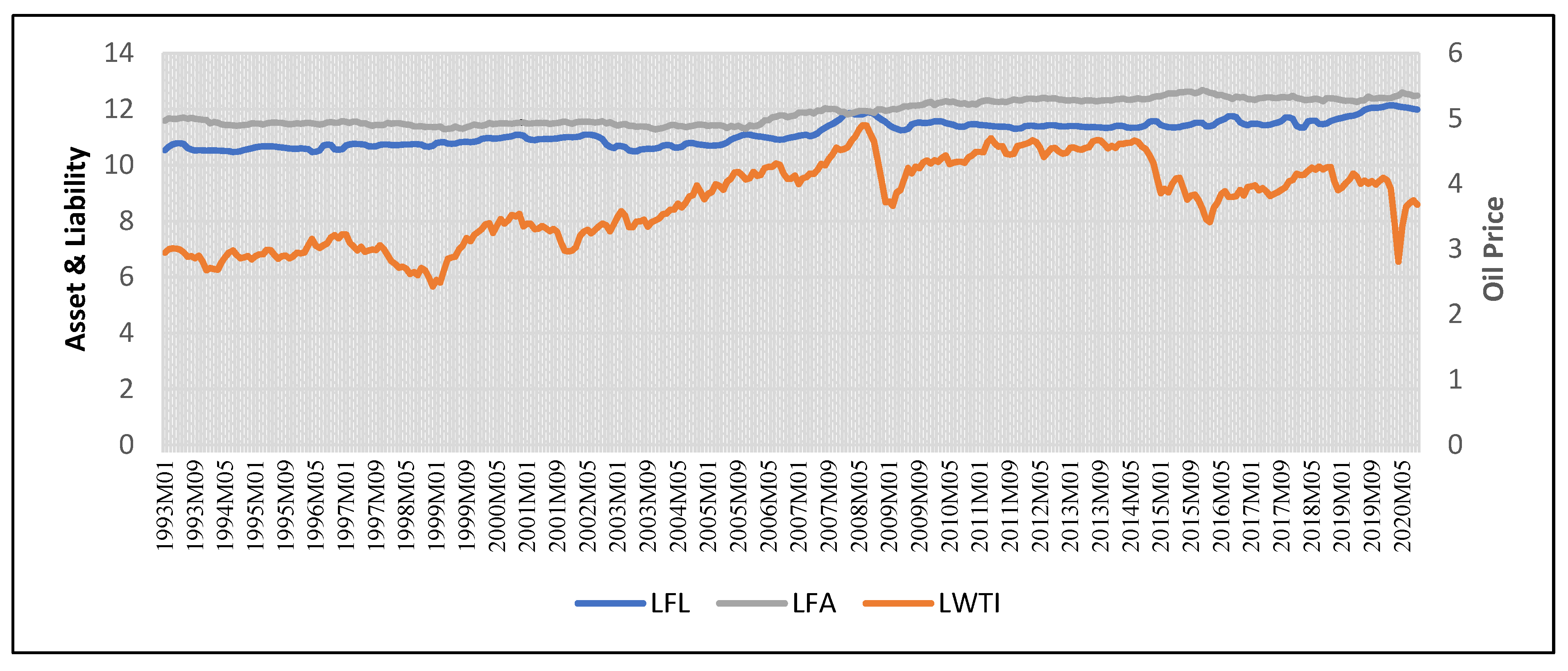
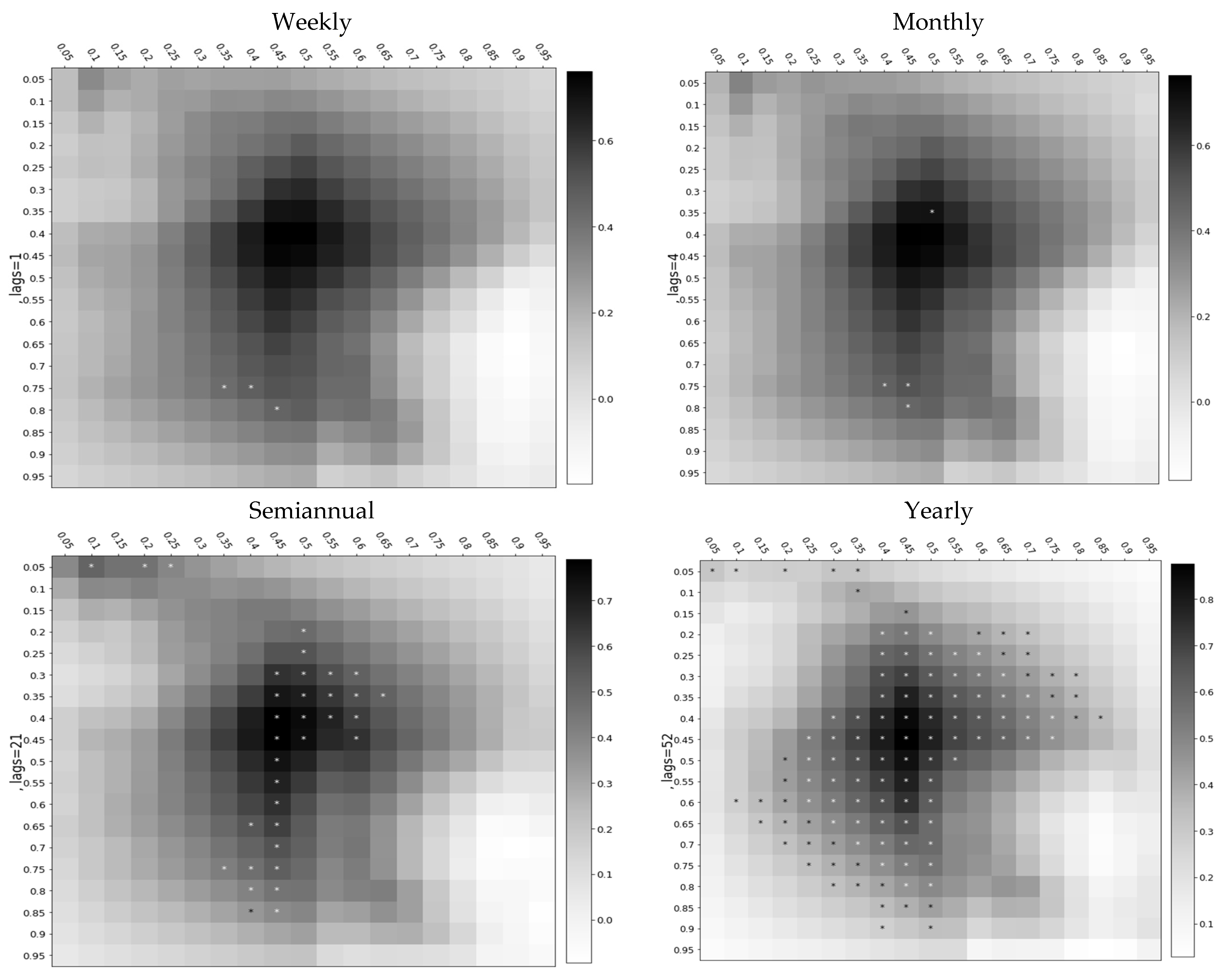
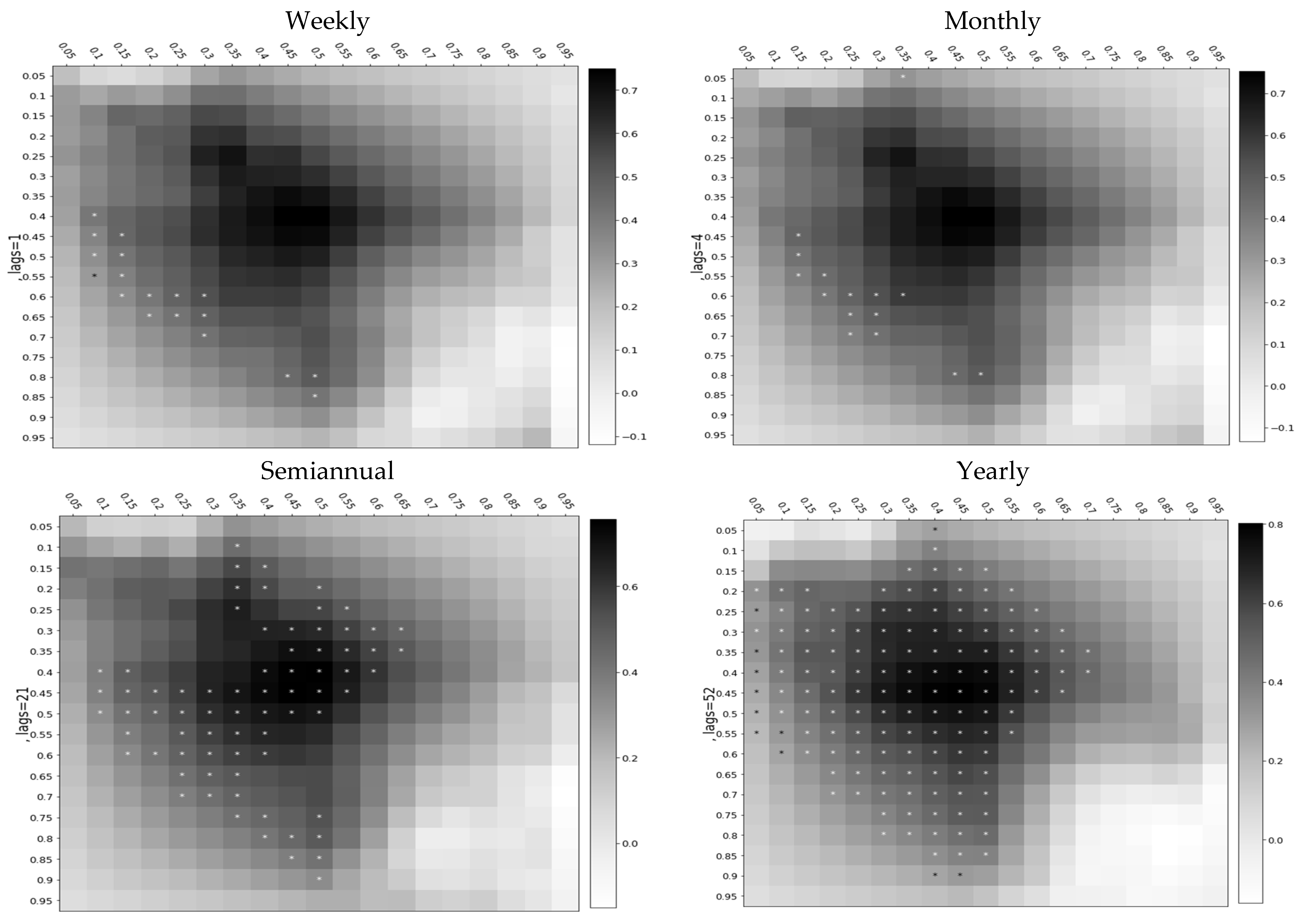
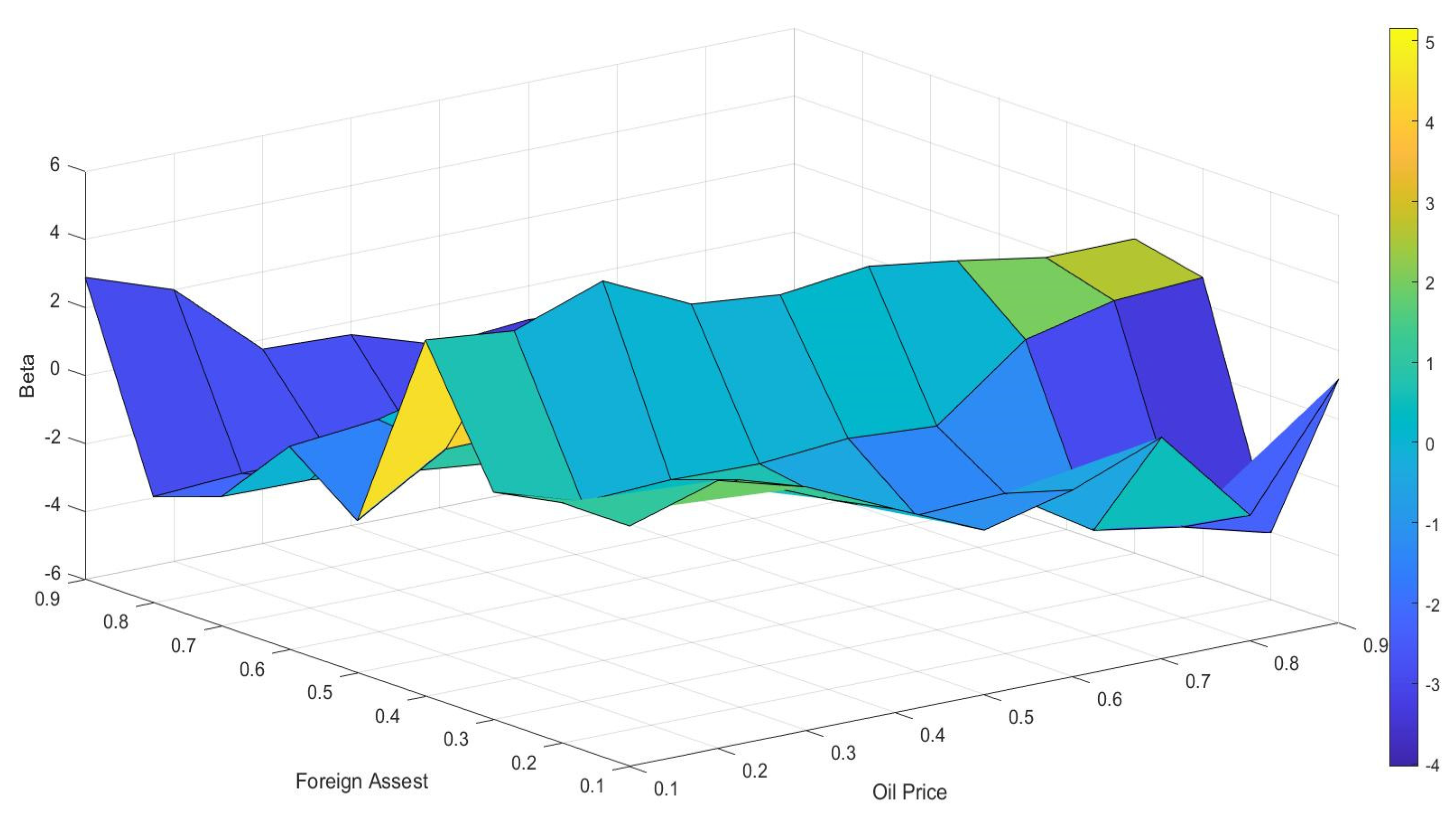
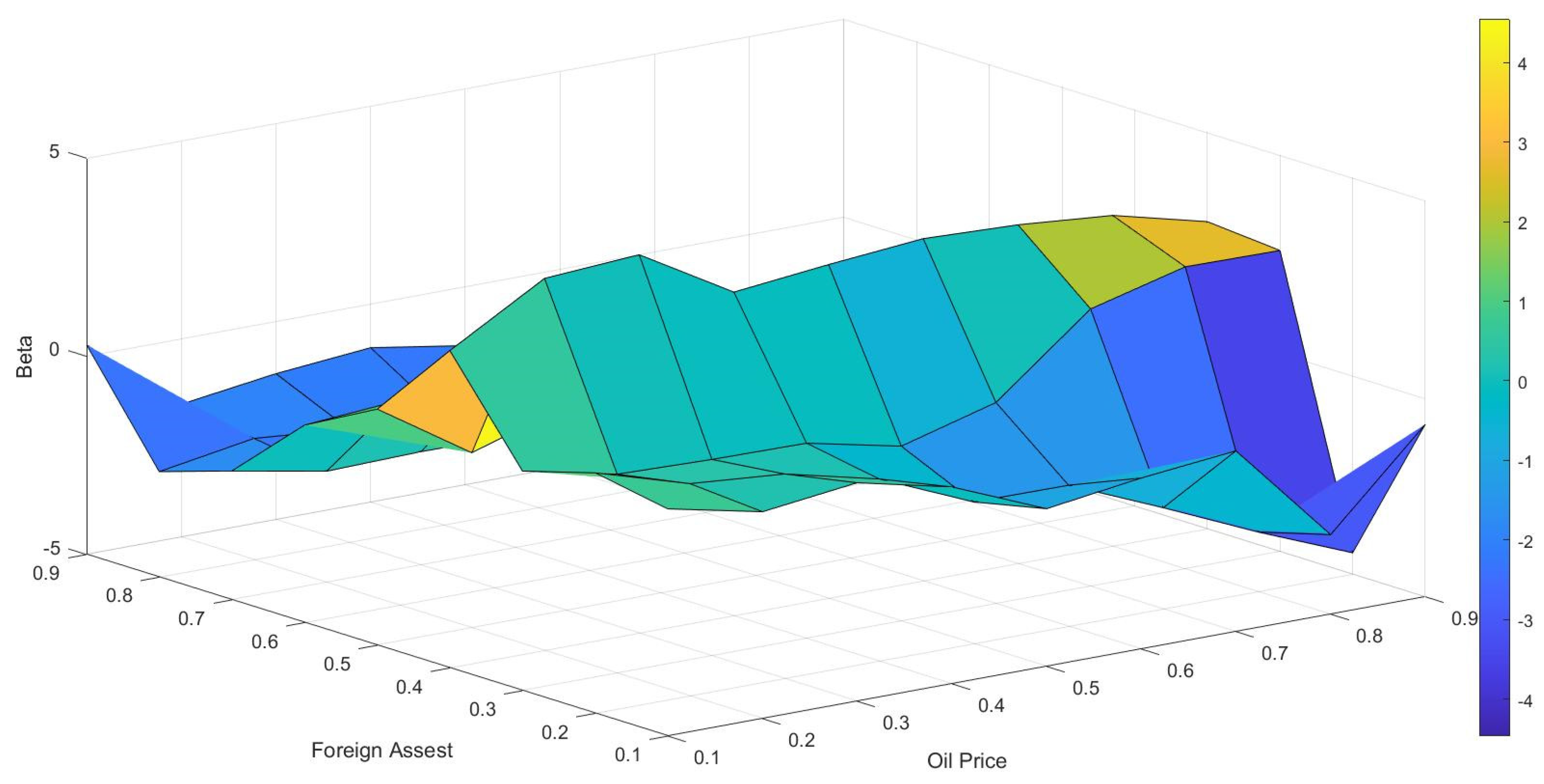
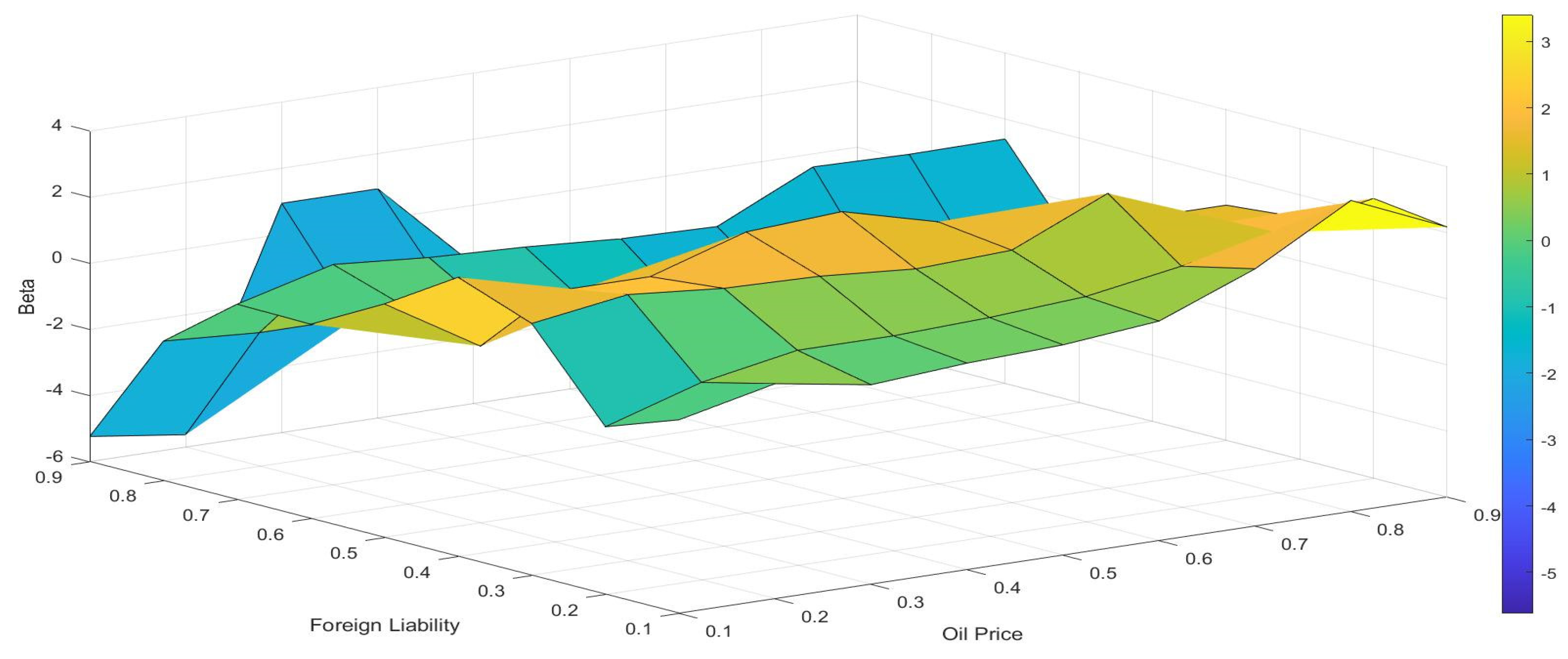
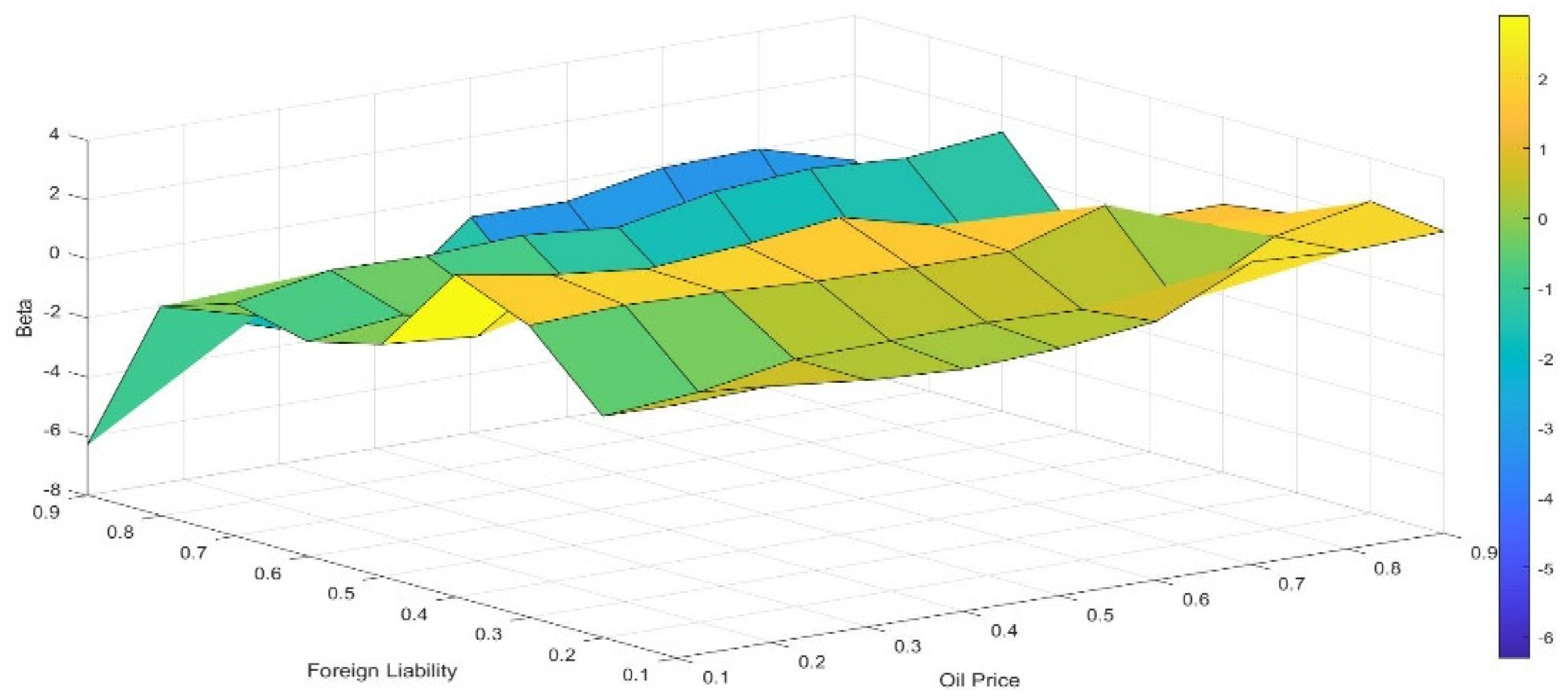
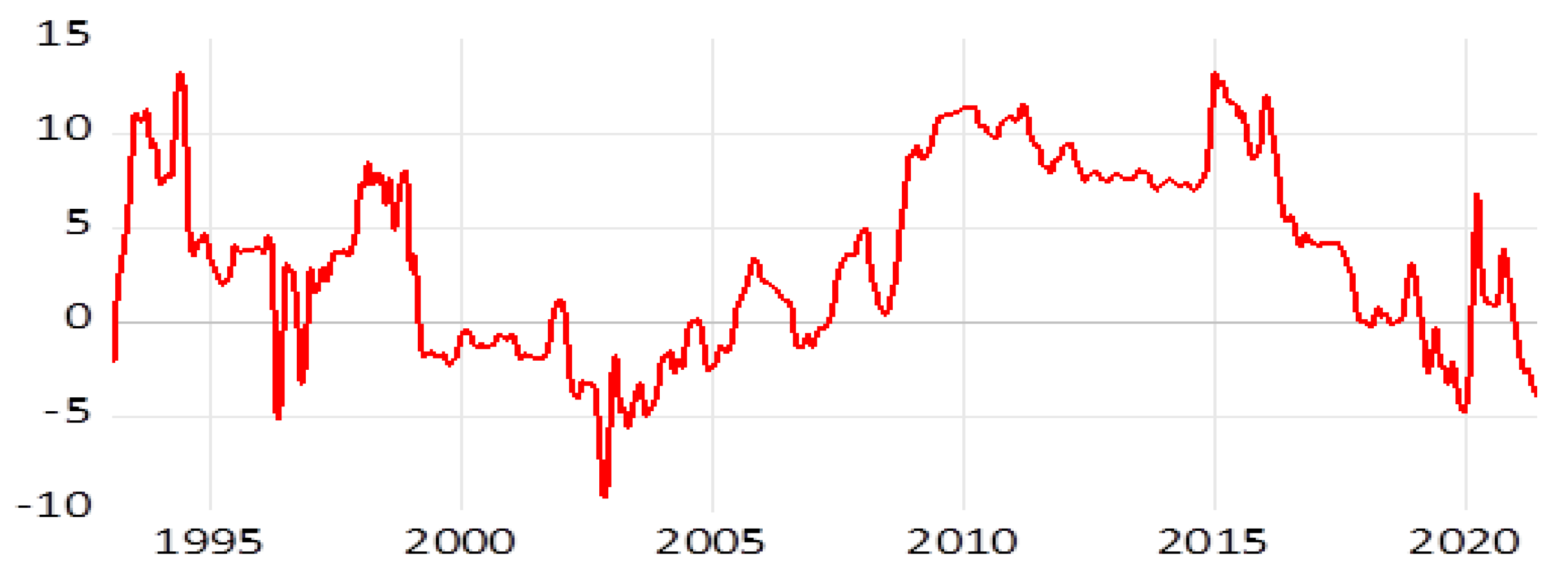
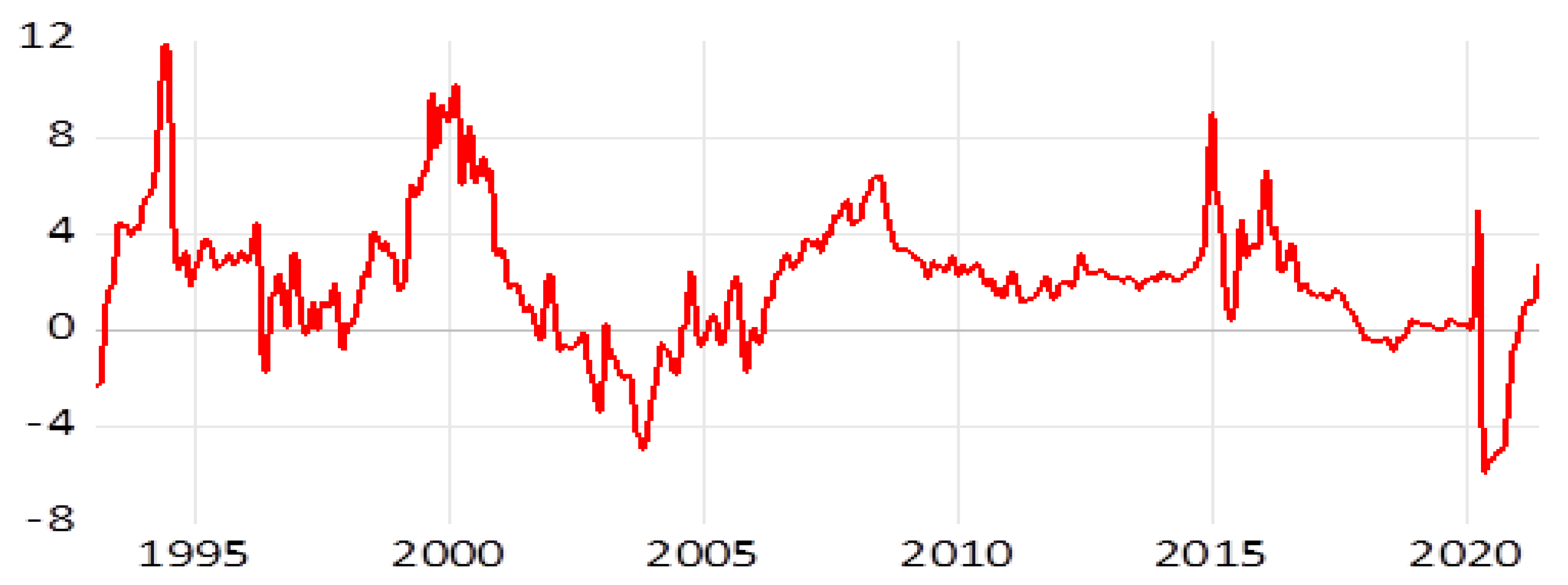
| Variable | Definition | Source |
|---|---|---|
| Foreign Assets (FAs) | Foreign assets (FAs) refer to the amount of foreign assets that Saudi Arabia owns in USD | Saudi Central Bank |
| Foreign Liabilities (FLs) | Foreign liabilities indicate the assumed liabilities (in each case, as defined in the asset transfer agreements) that are to be assumed by the buyer from the foreign asset sellers pursuant to the asset transfer agreements in USD | Saudi Central Bank |
| Oil price (OP) | Weekly international oil price based on West Texas Intermediate (WTI) | U.S. Energy Information Administration (EIA) |
| FA | FL | OP | |
|---|---|---|---|
| Mean | 11.8868 | 11.1730 | 3.7400 |
| Median | 11.8548 | 11.0919 | 3.8437 |
| Maximum | 12.6918 | 12.5082 | 4.9111 |
| Minimum | 11.2679 | 10.45915 | 2.4186 |
| Std. Dev. | 0.4315 | 0.475522 | 0.621013 |
| Skewness | 0.1650 | 0.5098 | −0.168026 |
| Kurtosis | 1.3829 | 2.6583 | 1.8103 |
| Jarque–Bera | 168.7683 | 71.6469 | 94.6893 |
| Probability | 0.0000 | 0.0000 | 0.0000 |
| ERS | 26.3202 *** | 41.3138 *** | 15.7693 *** |
| Sum | 17675.72 | 16614.36 | 5561.516 |
| Sum Sq. Dev. | 276.7558 | 336.0155 | 573.0866 |
| Observations | 1487 | 1487 | 1487 |
Publisher’s Note: MDPI stays neutral with regard to jurisdictional claims in published maps and institutional affiliations. |
© 2022 by the authors. Licensee MDPI, Basel, Switzerland. This article is an open access article distributed under the terms and conditions of the Creative Commons Attribution (CC BY) license (https://creativecommons.org/licenses/by/4.0/).
Share and Cite
Samargandi, N.; Sohag, K. Oil Price Shocks to Foreign Assets and Liabilities in Saudi Arabia under Pegged Exchange Rate. Mathematics 2022, 10, 4752. https://doi.org/10.3390/math10244752
Samargandi N, Sohag K. Oil Price Shocks to Foreign Assets and Liabilities in Saudi Arabia under Pegged Exchange Rate. Mathematics. 2022; 10(24):4752. https://doi.org/10.3390/math10244752
Chicago/Turabian StyleSamargandi, Nahla, and Kazi Sohag. 2022. "Oil Price Shocks to Foreign Assets and Liabilities in Saudi Arabia under Pegged Exchange Rate" Mathematics 10, no. 24: 4752. https://doi.org/10.3390/math10244752
APA StyleSamargandi, N., & Sohag, K. (2022). Oil Price Shocks to Foreign Assets and Liabilities in Saudi Arabia under Pegged Exchange Rate. Mathematics, 10(24), 4752. https://doi.org/10.3390/math10244752







